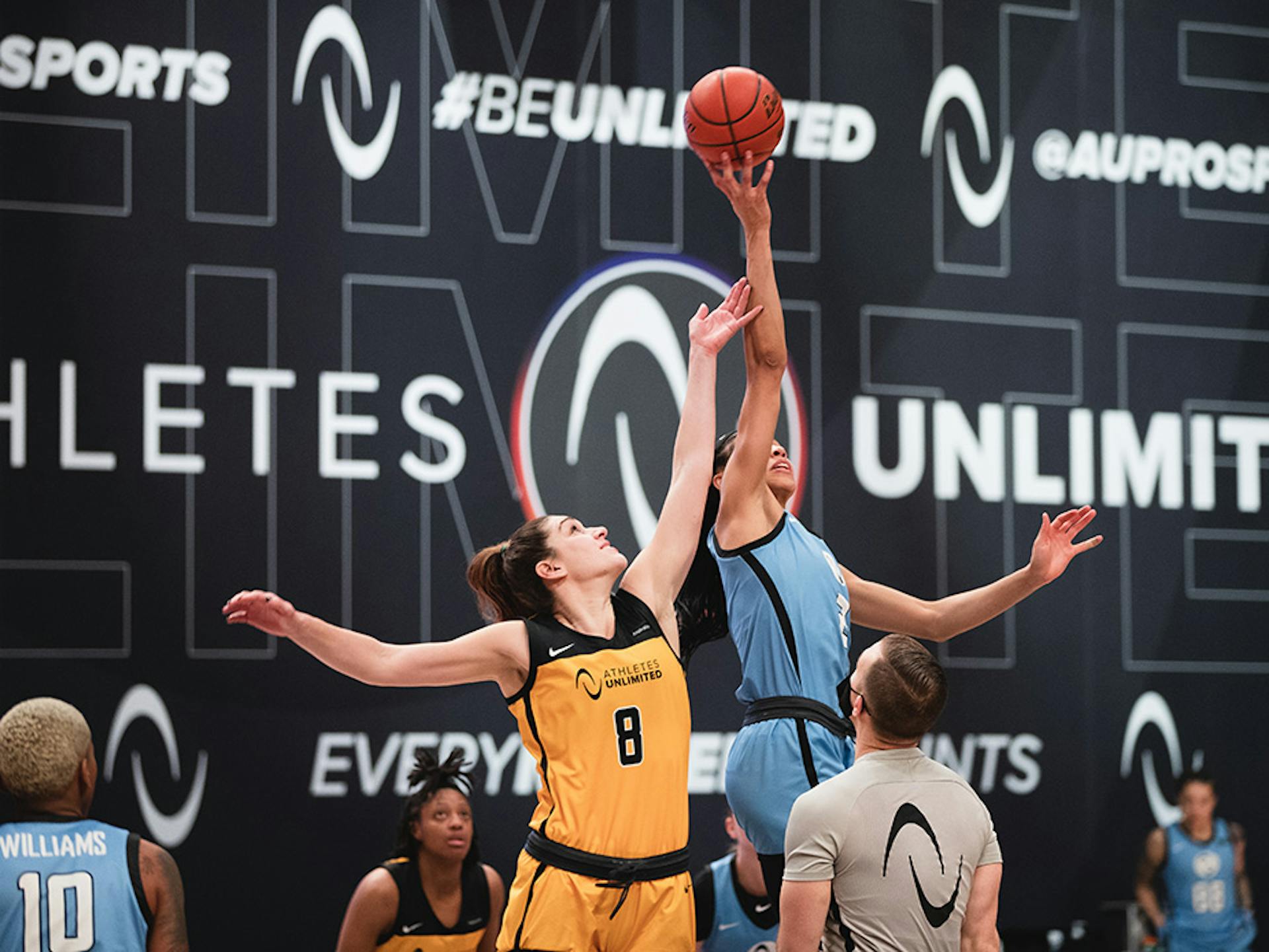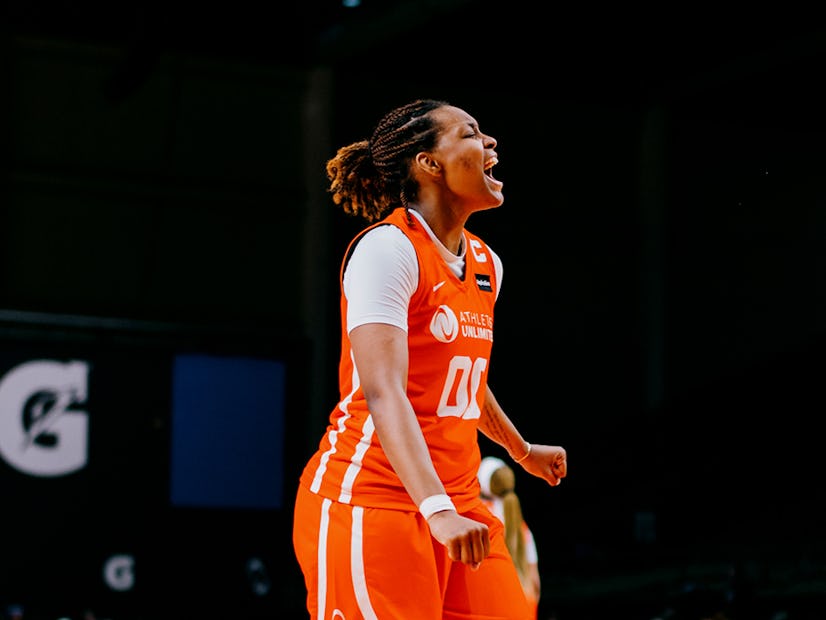
Basketball: Format & Rules
Athletes Unlimited Basketball features 44 players competing in a five-week season. Season 2 begins on February 23, 2023.
2023 Location: Dallas, Texas | Fair Park Coliseum
Here’s how Athletes Unlimited’s rules for its women’s professional basketball league compare to those of the WNBA, NBA, and FIBA.
Scoring
Two points are awarded for a field goal made from inside the 3-point arc and three points are awarded for a field goal made from behind the 3-point arc. One point is awarded for a made free throw. The team with the most points at the end of four quarters wins the game. If it is tied after four quarters, an overtime period of five minutes is played. The teams continue playing overtime periods until one team wins.
Unlike other professional basketball leagues, Athletes Unlimited has another component to scoring via a Leaderboard. While athletes score for their team, they also accumulate individual points based on stats, quarter wins, game wins and MVP honors.
Learn more about the Athletes Unlimited Point System
Duration of game
- AU: Four 10-minute quarters
- WNBA: Four 10-minute quarters
- NBA: Four 12-minute quarters
- FIBA: Four 10-minute quarters
Shot clock
- AU: 24 seconds
- WNBA: 24 seconds
- NBA: 24 seconds
- FIBA: 24 seconds
Backcourt violation
- AU: 8 seconds
- WNBA: 8 seconds
- NBA: 8 seconds
- FIBA: 8 seconds
Game clock stoppages after a successful field goal
- AU: The last minute of the first, second and third quarters and the last two minutes of the fourth quarter and each overtime period
- WNBA: Last minute of each quarter and overtime
- NBA: Last minute of the first, second and third quarters and last two minutes of the fourth quarter and each overtime period
- FIBA: The last 2 minutes of the fourth quarter and each overtime period
Foul limit
- AU: 6
- WNBA: 6
- NBA: 6
- FIBA: 5
Technical fouls
- AU: Do not count toward disqualification
- WNBA: Do not count toward disqualification
- NBA: Count toward disqualification
- FIBA: Count toward disqualification
Bonus free throws
- AU: Two free throws are awarded on the fifth foul of each quarter; if a team has not committed its quota of four team fouls during the first eight minutes of any regulation period or its quota of three team fouls during the first three minutes of any overtime period, it shall be permitted to incur one team foul during the last two minutes without penalty. Teams shoot two free throws on the fourth foul of overtime.
- WNBA: Two free throws are awarded on the fifth foul of each quarter. If the limit has not been reached in the final minute of each quarter, teams shoot two free throws on the second foul. Teams shoot two free throws on the fourth foul of overtime.
- NBA: Two free throws on the fifth foul of each quarter; if limit has not been reached by the final 2 minutes of each quarter, teams shoot two free throws on the second foul. Two free throws are awarded on the fourth foul of overtime.
- FIBA: Two free throws are awarded on the fifth foul of each quarter; overtime periods are considered part of the fourth quarter.
Time permitted on foul shots
- AU: 10 seconds
- WNBA: 10 seconds
- NBA: 10 seconds
- FIBA: 5 seconds
Lane violation during free throws
- AU: A successful free throw is forfeited if a teammate has stepped into the lane, but not if an opponent steps into the lane. If an opponent violates, the shooter shall receive a substitute free throw if their attempt is unsuccessful but shall be ignored if the attempt is successful. If a teammate and opponent both violate, a jump ball shall be administered at midcourt between any two opponents in the game.
- WNBA: A successful free throw is forfeited if a teammate has stepped into the lane, but not if an opponent steps into the lane. If an opponent steps into the lane before a shot and the free throw is not successful, another free throw is awarded to the shooter.
- NBA: A successful free throw is forfeited if a teammate has stepped into the lane, but not if an opponent steps into the lane. If an opponent steps into the lane before a shot and the free throw is not successful, another free throw attempt is awarded to the shooter.
- FIBA: If anyone other than the free throw shooter steps into the lane before a shot and the free throw is successful, no violation is called. If an opponent of the free throw shooter steps into the lane before a shot and the free throw is not successful, another free throw attempt is awarded to the shooter.
Timeouts
- AU: Three 30-second timeouts and one full timeout for each team per regulation game. (All timeouts carry over and none are lost if not used.) Each team shall be entitled to one additional 30-second timeout during each overtime in addition to any timeouts it has not used previously.
- WNBA: Two full (one-minute) timeouts and one 20-second timeout per half; 20-second timeouts not used in the first half will carry over to the second half. One full timeout and one 20-second timeout each overtime period, plus one unused 20-second timeout carried over from the second half if available.
- NBA: Six full (one-minute) timeouts during regulation; no more than three timeouts in the fourth quarter and no more than two timeouts in the final two minutes of regulation. Three full timeouts per overtime period; no more than two timeouts in the final two minutes of the extra period. One additional 20-second timeout per half, two total per game, including overtime.
- FIBA: Five one-minute timeouts (two at any point in the first half, three at any point in the second half); one timeout per overtime period; unused timeouts may not be carried over
Timeouts called by
- AU: Player or facilitator, when their team has possession or during a dead ball situation
- WNBA: Player or coach, when their team has possession or during a dead ball situation
- NBA: Player or coach, when their team has possession or during a dead ball situation
- FIBA: Coach, only after a basket by the opposing team or a dead ball situation
Tie-ups decided by
- AU: Jump ball
- WNBA: Jump ball
- NBA: Jump ball
- FIBA: Alternating possession
The Captain
- A team may have a captain and a co-captain numbering a maximum of two. The designated captain for the week will be known by the team name and color.
- The captain and/or facilitator is the only player who may ask an official about a rule interpretation during a regular or 20-second timeout charged to their team. They may not discuss a judgment decision.
- If the team captain continues to sit on the bench, they remain the captain for the entire game.
- In the event that the captain is absent from the court and bench, their facilitator shall immediately step in to serve as the new captain for the remainder of the game.
Captain’s Challenge
A captain may trigger a replay review of certain events subject to the provisions of the rule. Each team is entitled to one Challenge in the first thirty-eight minutes of the game, and one Challenge in the last two minutes of the fourth quarter (2:00 or less in the fourth quarter) or overtime.
A team may utilize a Challenge to trigger a replay review of the following events:
- A called personal foul charged to its own team
- A called out-of-bounds violation.
Replay review of the following events, among others, may not be triggered by a Challenge:
- A called personal foul charged to the opposing team:
- Continuation – i.e., whether a defensive foul occurred prior to the offensive player beginning their shooting motion
- A technical or flagrant foul
- Violations – i.e., traveling, carrying, double dribble, offensive or defensive three seconds, etc.
- Any aspect related to continuation constitutes a reviewable matter when a called foul is properly challenged, however, continuation is not by itself an independent challengeable event.
To initiate a Challenge, the challenging team must take the following steps in sequence:
- The challenging team must call a legal timeout immediately after the call in question (unless a electric media timeout or timeout called by the opposing team is already underway).
- The challenging team’s captain must simultaneously signal for a Challenge by utilizing the replay signal – twirling an index finger – toward the game official(s) during the same interaction with the game official(s) in which the timeout was called.
- During the same interaction with the game official(s) in which the challenging team’s captain signals for the Challenge, the challenging team’s captain must notify the game official(s) of the specific event that the team is challenging.




